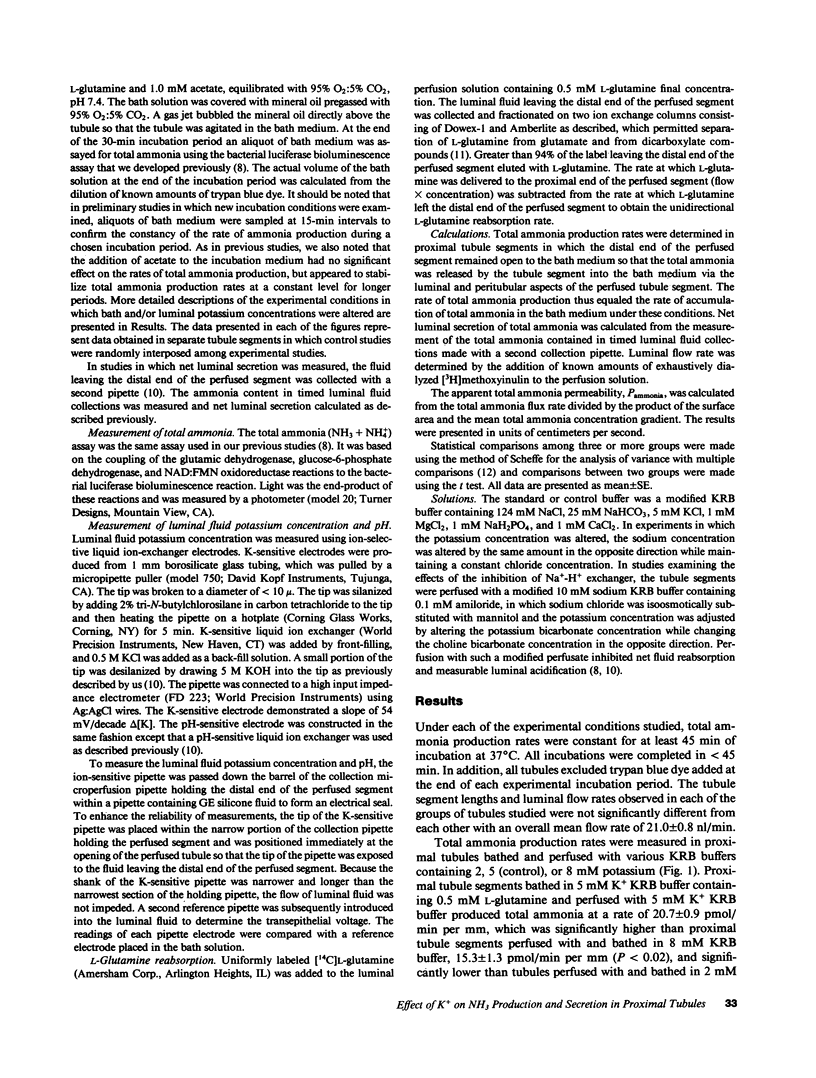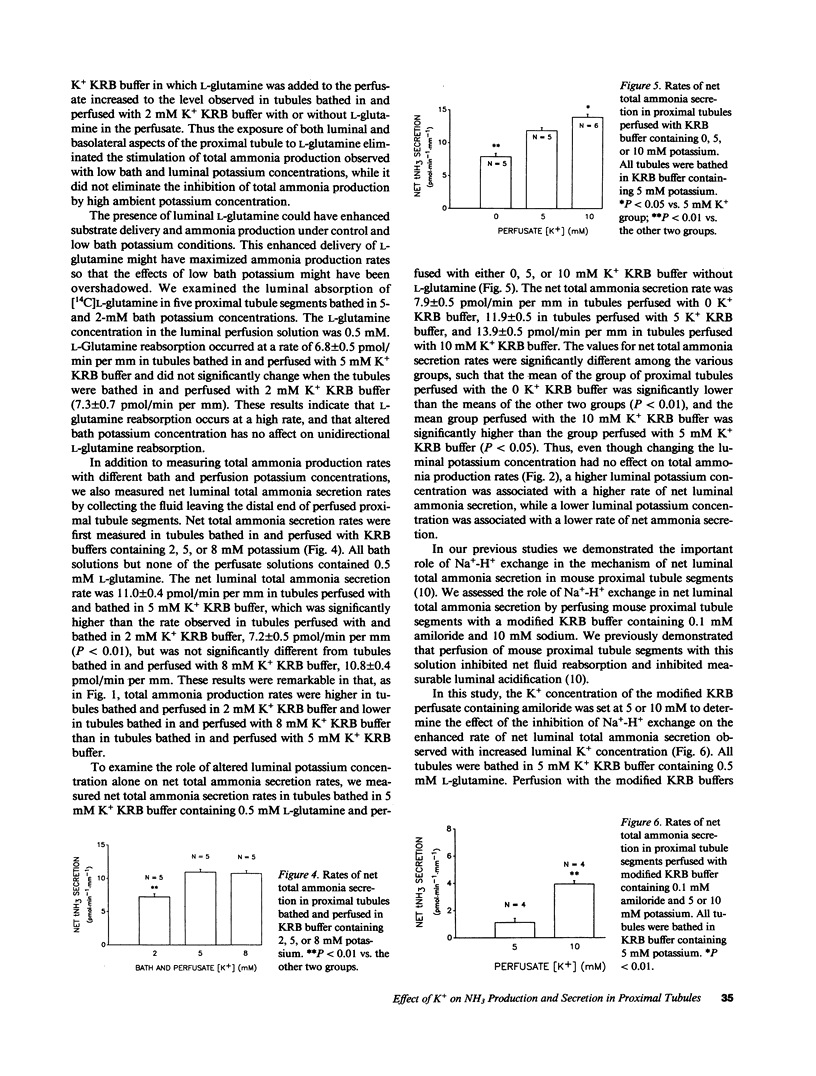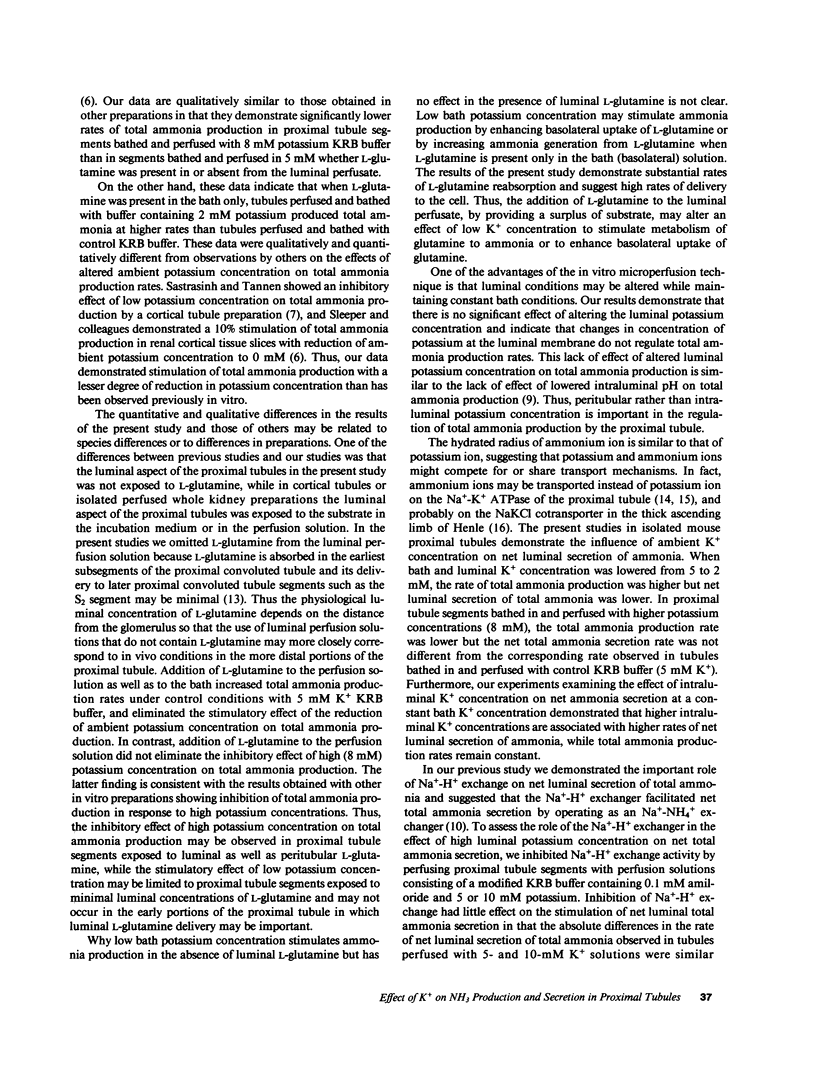Abstract
To determine the effects of acute changes in K+ concentration in vitro on ammonia production and secretion by the proximal tubule, we studied mouse S2 segments perfused with and bathed in Krebs-Ringer bicarbonate buffers containing various K+ concentrations. All bath solutions contained L-glutamine as the ammoniagenic substrate. High bath and luminal K+ concentrations (8 mM), but not high luminal K+ concentration alone, inhibited total ammonia production rates by 26%, while low bath and luminal K+ concentrations (2 mM), but not low luminal K+ concentration alone, stimulated total ammonia production rates by 33%. The stimulation of ammonia production by low bath K+ concentration was not observed when L-glutamine was added to the luminal perfusion solution. On the other hand, high luminal K+ concentration stimulated, while low luminal K+ concentration inhibited, net luminal secretion of total ammonia in a way that was: (a) independent of total ammonia production rates, (b) independent of Na(+)-H+ exchange activity, and (c) not due to changes in transepithelial fluxes of total ammonia. These results suggest that luminal potassium concentration has a direct effect on cell-to-lumen transport of ammonia.
Full text
PDF







Selected References
These references are in PubMed. This may not be the complete list of references from this article.
- BAERTL J. M., SANCETTA S. M., GABUZDA G. J. Relation of acute potassium depletion to renal ammonium metabolism in patients with cirrhosis. J Clin Invest. 1963 May;42:696–706. doi: 10.1172/JCI104761. [DOI] [PMC free article] [PubMed] [Google Scholar]
- Garvin J. L., Burg M. B., Knepper M. A. Ammonium replaces potassium in supporting sodium transport by the Na-K-ATPase of renal proximal straight tubules. Am J Physiol. 1985 Nov;249(5 Pt 2):F785–F788. doi: 10.1152/ajprenal.1985.249.5.F785. [DOI] [PubMed] [Google Scholar]
- Garvin J. L., Burg M. B., Knepper M. A. NH3 and NH4+ transport by rabbit renal proximal straight tubules. Am J Physiol. 1987 Feb;252(2 Pt 2):F232–F239. doi: 10.1152/ajprenal.1987.252.2.F232. [DOI] [PubMed] [Google Scholar]
- Good D. W. Effects of potassium on ammonia transport by medullary thick ascending limb of the rat. J Clin Invest. 1987 Nov;80(5):1358–1365. doi: 10.1172/JCI113213. [DOI] [PMC free article] [PubMed] [Google Scholar]
- Kamm D. E., Strope G. L. Glutamine and glutamate metabolism in renal cortex from potassium-depleted rats. Am J Physiol. 1973 Jun;224(6):1241–1248. doi: 10.1152/ajplegacy.1973.224.6.1241. [DOI] [PubMed] [Google Scholar]
- Kurtz I., Balaban R. S. Ammonium as a substrate for Na+-K+-ATPase in rabbit proximal tubules. Am J Physiol. 1986 Mar;250(3 Pt 2):F497–F502. doi: 10.1152/ajprenal.1986.250.3.F497. [DOI] [PubMed] [Google Scholar]
- Nagami G. T., Kurokawa K. Regulation of ammonia production by mouse proximal tubules perfused in vitro. Effect of luminal perfusion. J Clin Invest. 1985 Mar;75(3):844–849. doi: 10.1172/JCI111781. [DOI] [PMC free article] [PubMed] [Google Scholar]
- Nagami G. T. Luminal secretion of ammonia in the mouse proximal tubule perfused in vitro. J Clin Invest. 1988 Jan;81(1):159–164. doi: 10.1172/JCI113287. [DOI] [PMC free article] [PubMed] [Google Scholar]
- Nagami G. T., Sonu C. M., Kurokawa K. Ammonia production by isolated mouse proximal tubules perfused in vitro. Effect of metabolic acidosis. J Clin Invest. 1986 Jul;78(1):124–129. doi: 10.1172/JCI112540. [DOI] [PMC free article] [PubMed] [Google Scholar]
- Pagliara A. S., Goodman A. D. Relation of renal cortical gluconeogenesis, glutamate content, and production of ammonia. J Clin Invest. 1970 Nov;49(11):1967–1974. doi: 10.1172/JCI106416. [DOI] [PMC free article] [PubMed] [Google Scholar]
- Pishak M. R., Phillips A. T. A modified radioisotopic assay for measuring glutamine synthetase activity in tissue extracts. Anal Biochem. 1979 Apr 1;94(1):82–88. doi: 10.1016/0003-2697(79)90793-0. [DOI] [PubMed] [Google Scholar]
- Sastrasinh S., Tannen R. L. Effect of potassium on renal NH3 production. Am J Physiol. 1983 Apr;244(4):F383–F391. doi: 10.1152/ajprenal.1983.244.4.F383. [DOI] [PubMed] [Google Scholar]
- Silbernagl S. Tubular reabsorption of L-glutamine studied by free-flow micropuncture and microperfusion of rat kidney. Int J Biochem. 1980;12(1-2):9–16. doi: 10.1016/0020-711x(80)90034-8. [DOI] [PubMed] [Google Scholar]
- Simon E. E., Fry B., Hering-Smith K., Hamm L. L. Ammonia loss from rat proximal tubule in vivo: effects of luminal pH and flow rate. Am J Physiol. 1988 Nov;255(5 Pt 2):F861–F867. doi: 10.1152/ajprenal.1988.255.5.F861. [DOI] [PubMed] [Google Scholar]
- Sleeper R. S., Belanger P., Lemieux G., Preuss H. G. Effects of in vitro potassium on ammoniagenesis in rat and canine kidney tissue. Kidney Int. 1982 Feb;21(2):345–353. doi: 10.1038/ki.1982.28. [DOI] [PubMed] [Google Scholar]
- Szylman P., Better O. S., Chaimowitz C., Rosler A. Role of hyperkalemia in the metabolic acidosis of isolated hypoaldosteronism. N Engl J Med. 1976 Feb 12;294(7):361–365. doi: 10.1056/NEJM197602122940703. [DOI] [PubMed] [Google Scholar]
- Tannen R. L. Relationship of renal ammonia production and potassium homeostasis. Kidney Int. 1977 Jun;11(6):453–465. doi: 10.1038/ki.1977.63. [DOI] [PubMed] [Google Scholar]
- Tannen R. L. The effect of uncomplicated potassium depletion on urine acidification. J Clin Invest. 1970 Apr;49(4):813–827. doi: 10.1172/JCI106295. [DOI] [PMC free article] [PubMed] [Google Scholar]
- Tannen R. L., Wedell E., Moore R. Renal adaptation to a high potassium intake. The role of hydrogen ion. J Clin Invest. 1973 Sep;52(9):2089–2101. doi: 10.1172/JCI107394. [DOI] [PMC free article] [PubMed] [Google Scholar]


